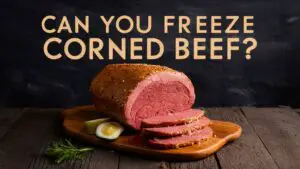Bringing home a half cow is an exciting milestone for any home chef. As you eagerly anticipate all that delicious, farm-fresh beef, visions of steaks, roasts, and ground beef dance in your head. But before the beef arrives, an important question looms – how much freezer space do you really need to store a half cow?
As a long-time farmer’s market customer now preparing for my first half cow purchase, I’ve done extensive research to ensure I don’t end up with a frozen beef pile-up in my garage fridge. Through conversations with farmers, experienced beef buyers, and expert home organizers, I’ve gathered best practices for calculating freezer space needs down to a science.
Key Facts:
- A half cow yields 160-220 pounds of packaged beef
- General rule of thumb is 7-10 cubic feet per 35-40 pounds
- Minimum recommended space is 8-10 cubic feet
- Consider type of cuts, packaging, and freezer layout
- Allow for extra room beyond the basics to avoid tight squeezes
Let’s dive in as I transform from beef storage novice to freezer space expert – complete with handy reference charts, insider tips from veterans, and a peek into my own half cow prep!
Calculating Your Beef Cubes: Freezer Space Math Basics
Freezers may seem like mysterious black holes, but a few simple calculations help uncover their true spatial mysteries. Here’s the core formula:
1/2 Cow Yield x Freezer Space Ratio = Minimum Cubic Feet
Let’s break this down:
Half Cow Yield: From my farmer, I know I’ll receive approximately 180 pounds of packaged beef from my half cow, a pretty typical yield.
Freezer Space Ratio: The experts recommend allowing 7-10 cubic feet per 35-40 pounds of meat. I’m using the more conservative 1:10 ratio to allow for some heavy roasts and bone storage.
Minimum Cubic Feet: Now for the math: 180 pounds x 10 cubic feet per 35 pounds = approx. 51 cubic feet.
My Space Reality Check: My current freezer is just 5 cubic feet. I’ll need to seriously upgrade my capacity! Using the 1:10 ratio, I’ll shop for a minimum 12 cubic foot freezer to allow for some flexibility.
Let’s explore those key elements impacting freezer space needs:
Not All Cows Yield Equally
Cattle come in different breeds, sizes, ages, and feed regimens. A behemoth Angus bull will naturally yield more beef than a grass-fed heifer. Ask your farmer for an estimate of hanging weight – this excludes bones/fat and gives you an idea of packaged meat yield.
My 180 pound yield estimate is based on a 2 year old grain-finished steer. Grass-fed or smaller cattle may clock in closer to 160 pounds hanging weight.
Freezer Space Ratios: Finding the Sweet Spot
Freezer space rules go something like this:
- 7 cu feet per 35 lbs meat = tight squeeze
- 8 cu ft per 40 lbs = better fit
- 10 cu ft per 35 lbs = comfy buffer
I don’t like tight spaces, so I’m opting for a minimum 1:10 ratio, hence my 12 cubic foot target. For you, 8 cubic feet could work fine with vacuum-sealed meat and minimal bones. Know your preferences!
Packaging: Shrink Wrap vs Vacuum Seal
Packaging plays a key role in space efficiency. While traditional shrink wrap contains meat shape, it leaves air pockets that take up precious real estate.
Vacuum sealing, on the other hand, sucks every last bit of air out of the package to cling tight to contours. I’ll be requesting vacuum-sealed cuts, which can condense packages to about 75% of their original size.
Freezer Type and Organization
Chest freezers offer maximum space for the footprint, but make finding items a freezer dive expedition. Upright freezers take up slightly more floor space, but shelves and baskets provide handy storage options.
I’m going with an upright to handle irregular shapes from roasts and bones. I’ll also be using clear bins for ground beef and small cuts like cube steaks to optimize organization.
Sizing Up Freezers: Models, Features, and Reviews
Now that I understand the core calculations, it’s time to turn theory into an actual, tangible freezer for my garage. I’ll compare the leading options to determine the best freezer for my half cow needs.
After measuring my garage and considering configuration, I determined a 14 cubic foot upright freezer will perfectly suit my needs with some room to spare.
Next, I compared ratings and reviews on sites like Consumer Reports and The Spruce Eats for performance metrics like temperature consistency, energy efficiency, and noise.
Through my research, two freezers emerged as prime contenders:
1. GE 14 cu. ft. Upright Freezer
- Cubic Feet: 14
- Type: Upright
- Ratings Snapshot
- Overall Score: 4.5/5
- Temperature Consistency: Very Good
- Noise Level: Very Quiet
- Key Features
- Adjustable shelves and wire baskets
- Reversible door
- Interior lighting
- Smooth back design
2. Fridgidaire 14.4 cu. ft. Upright Freezer
- Cubic Feet: 14.4
- Type: Upright
- Ratings Snapshot
- Overall Score: 4.3/5
- Temperature Consistency: Very Good
- Noise Level: Quiet
- Key Features
- Slide-out bulk storage basket
- Interior lighting
- Reversible door
- 2 full-width shelves
While both models boast excellent space and strong performance, I’m going with the GE for the flexible 3-bin storage system to keep my meat perfectly organized.
Now I’ll share my complete freezer prep game plan, from defrosting to labeling and beyond!
Preparing Your Freezer for Beefy Success
My shiny new upright freezer arrives next week, which sparks the beginning of Operation Meat Mountain. Here are my essential steps for priming my freezer for maximum beef enjoyment:
Step 1: Defrost and Clean
I’ll turn the temperature to max for a full 24 hours in advance to soften any existing ice or walls, making it easier to fully sanitize every nook and cranny. Safety first!
Step 2: Take Inventory
I’ll take stock of what’s already chilling in my current freezer to determine if I need to cook, donate, or discard anything before the beef invasion. Out with the old!
Step 3: Create Storage Zones
Using clear bins and baskets, I’ll designate zones for broad food categories:
- Beef cuts (steaks, roasts)
- Ground beef
- Soup bones
- Other frozen foods
Step 4: Label Everything
I’m creating a color-coded labeling system using freezer-safe tape to easily ID containers by type and date. This keeps rotation straightforward!
Step 5: Strategize Defrosting
I’m allocating one bin just for items I plan to defrost and eat within a week, avoiding fridge clutter. The upright design makes monitoring thawing progress easy.
Additional Tips for Freezer Domination
Beyond perfectly plotting your cubic footage, there are additional best practices for storing half cow quantities of frozen beef:
Go Big or Go Home on Freezer Size
Allow 15-20% more space than the minimum requirement to enable flexibility. Things pile up!
Take Inventory Before Bulk Buys
Know exactly what’s already chilling in your freezer before stashing beef. Consolidate or clean out unnecessary items.
Double Down on Organization
Consider an upright freezer for visibility and bin versatility. Categorize with clear containers.
Label Meets and Greet Your Meat
Use labels to track inventory by type and date. It makes for friendly freezer foraging!
Plot Your Defrosting Strategy
Remember, large cuts require multi-day defrosting. Prioritize a defrosting bin for what you’ll use soon.
Beef Up Your Cooking Skills
Don’t let prime cuts languish! Brush up on recipes and techniques before your bounty arrives.
Top Off Your Supply
Leave 10-20% empty space to allow for expansion and to maintain freezing efficiency.
Freezer Space FAQs: Your Top Half Cow Questions Answered
What size chest freezer fits a half cow?
- For a half cow, a 15 cubic foot chest freezer is recommended minimum. Uprights offer more organization.
How long does a half beef last in the freezer?
- Properly packaged and stored at 0°F, frozen beef lasts 12 months in the freezer.
Can you fit a whole cow in a chest freezer?
- It’s tight, but possible. To fit a whole cow, aim for a minimum of 15 cubic feet chest freezer capacity.
What about bones and organs?
- Bones and organs require more irregular space. I recommend a minimum 12 cubic foot upright freezer for a half cow with bones.
Any special considerations for grass-fed beef?
- Grass-fed cattle tend to have less fat and smaller carcass size, yielding 10-15% less meat. Use the lower end of beef yield estimates.
Wrap Up: My Beefy Journey to Freezer Nerdvana
Who knew buying half cow could turn me into a beef nerd extraordinaire? I entered the freezer space vortex as a simple farmer’s market loyalist, but emerged a veritable beef baroness with knowledge bombs galore.
My beef bounty arrives next weekend, and I’m fully prepped with sparkling 14 cubic foot upright loaded with clear bins, thermometers, and color-coded labels. Consider me a cooler beef convict!
I hope all you aspiring beef buyers leave frozen inspired as well. Calculate your cubic footage, pick the perfect freezer, and get ready to meat out with your beefy best self!




